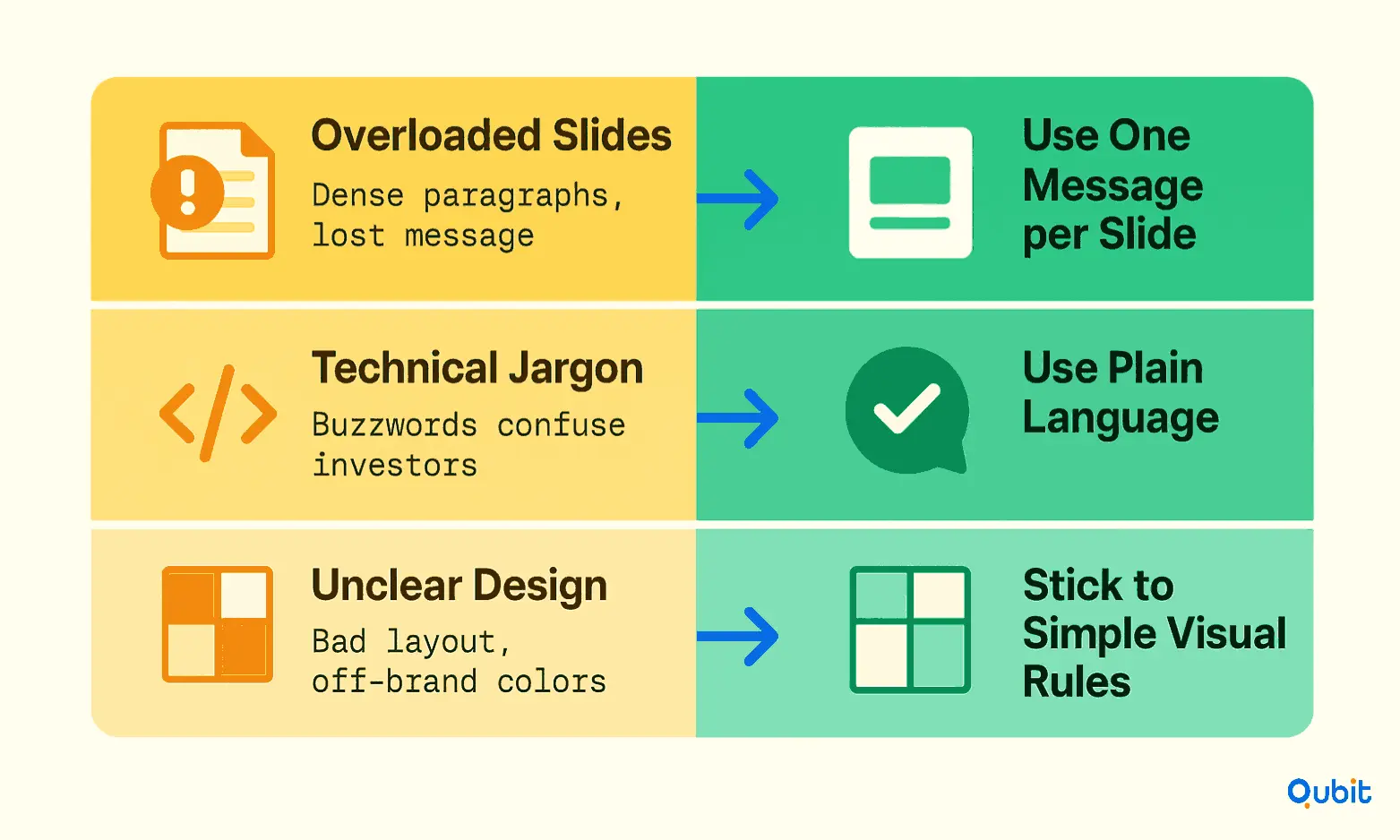A compelling pitch deck can be the difference between securing funding and being overlooked. Yet, many PropTech startups stumble on avoidable mistakes that weaken their investor appeal. From unclear market positioning to overambitious financial projections, these missteps can dilute the impact of even the most innovative ideas.
Insight into crafting a stronger narrative is explored in proptech data storytelling investors, which expands on methods to integrate data narratives within your pitch deck. By weaving robust data insights into your presentation, you can reinforce your market traction and build investor confidence.
This blog will uncover the most common pitfalls in PropTech pitch decks and provide actionable solutions to help you stand out. Let’s dive into the details and ensure your next pitch leaves a lasting impression.
Comprehensive Mistake Categories
Problem Definition Errors
Common Mistakes:
- Presenting generic real estate problems without specific market validation
- Failing to quantify the pain point's financial impact
- Describing problems that don't resonate with target customer segments
Solutions:
- Conduct primary research with 20+ target customers to validate specific pain points
- Quantify problem impact: "Property managers waste 15 hours weekly on manual processes, costing $2,400 monthly per property"
- Frame problems from the customer's perspective, not your solution's capabilities
Solution Presentation Failures
Common Mistakes:
- Over-explaining technical architecture instead of business benefits
- Unclear value proposition that doesn't differentiate from competitors
- Missing the "why now" element that makes timing critical
Solutions:
- Lead with business outcomes: "Reduces operational costs by 30%" before explaining how
- Create a clear one-sentence value proposition that a non-technical investor can understand
- Connect your solution to current market trends (AI adoption, remote work, sustainability regulations)
Team Presentation Weaknesses
Common Mistakes:
- Generic team descriptions without PropTech-relevant experience
- Missing key roles essential for PropTech success (regulatory compliance, real estate partnerships)
- Overemphasizing technical skills while underplaying market knowledge
Solutions:
- Highlight specific real estate industry experience and relationships
- Address key role gaps with advisors or planned hires
- Include customer development experience and market insights gained
Industry-Specific PropTech Considerations
| PropTech Vertical | Key Investor Concerns | Essential Metrics | Unique Considerations |
|---|---|---|---|
| Construction Tech | Safety compliance, project delays | Project completion time reduction, cost overrun elimination | Regulatory approvals, contractor adoption |
| Property Management | Tenant satisfaction, operational efficiency | Maintenance response time, occupancy rates | Integration with existing property systems |
| Real Estate Fintech | Security, regulatory compliance | Transaction volume, fraud reduction rates | Banking partnerships, compliance costs |
| Smart Buildings | ROI demonstration, technology integration | Energy savings, operational cost reduction | Installation complexity, building owner buy-in |
| PropTech SaaS | Scalability, customer acquisition | Monthly recurring revenue, customer lifetime value | Market saturation, switching costs |
The Information Overload Trap

Cramming Everything Into Every Slide
PropTech founders love their data. Market size projections, user analytics, technical specifications – they want to show it all. This creates slides that look like data dumps rather than compelling stories.
Investors don't want to read paragraphs of text during your presentation. They want key insights they can absorb quickly. When you overload slides with information, especially on problem slides, the core message gets buried.
The Fix:
- Limit text to essential bullet points only
- Use one core message per slide
- Save detailed data for appendix materials
- Replace dense paragraphs with impactful visuals
Technical Jargon That Confuses Rather Than Clarifies
PropTech startups often fall into the jargon trap. Terms like "blockchain-enabled smart contracts" or "machine learning property valuation algorithms" might sound impressive. But they create barriers instead of building understanding.
Your grandmother should understand your core value proposition. If she can't, neither will most investors during a 10-minute pitch.
The Fix:
- Use simple, everyday language
- Explain technical concepts through benefits, not features
- Test your pitch on non-technical people first
- Focus on outcomes rather than processes
Design Disasters That Kill First Impressions
Poor visual design isn't just aesthetic – it signals lack of attention to detail. Investors review dozens of decks daily. If yours looks amateur, it won't get a second glance.
Common Design Problems:
- Inconsistent fonts and colors across slides
- Low-quality images or generic stock photos
- Cluttered layouts with poor spacing
- Stretched logos and unprofessional graphics
The Professional Approach:
- Stick to 2-3 font sizes maximum
- Maintain consistent margins throughout
- Use high-quality, relevant imagery
- Keep visual elements aligned and balanced
Clean design makes your content easier to process. It shows you care about quality in everything you do.
The Storytelling Gap
Starting With Features Instead of Problems
Too many PropTech decks jump straight into product features. "Our platform has automated lease management, predictive maintenance alerts, and integrated payment processing." That's not a story – that's a feature list.
Real stories start with real problems. Paint the picture of a property manager drowning in paperwork. Show the frustrated tenant whose maintenance requests disappear into black holes. Make the problem tangible before introducing your solution.
Missing the Emotional Connection
Data tells, but stories sell. Investors fund people and missions, not just technologies. Your deck needs to create emotional investment in your success.
Building Better Narratives:
- Customer Journey Stories – Show before and after scenarios
- Founder Origin Stories – Explain why this problem matters to you personally
- Market Evolution Stories – Position your solution within industry transformation
From outline to credible slides: use this pitch deck software comparison to choose the right tool in minutes.
Business Model Confusion
The "Figure It Out Later" Approach
Some PropTech founders assume their innovation will automatically generate revenue. They focus on user acquisition without clear monetization strategies. This worked during the 2019 funding boom, but today's investors demand clear paths to profitability.
Revenue Model Clarity Issues:
- Vague pricing structures
- Unrealistic unit economics
- Missing customer acquisition costs
- No retention or churn analysis
Essential Business Model Elements:
| Component | What to Include | Why It Matters |
|---|---|---|
| Revenue Streams | Subscription, transaction fees, licensing | Shows multiple income sources |
| Pricing Strategy | Tiered options, value-based pricing | Demonstrates market understanding |
| Unit Economics | CAC, LTV, gross margins | Proves scalability potential |
| Growth Metrics | User acquisition, retention rates | Shows business momentum |
Market Analysis Missteps
Generic Market Research
Many PropTech decks present generic real estate market statistics. "The global real estate market is worth $3.7 trillion" doesn't help investors understand your specific opportunity
Effective market analysis focuses on your addressable segments. Are you targeting commercial property managers? Residential landlords? Real estate agents? Each has different pain points, buying behaviors, and growth trajectories.
Ignoring Market Timing
PropTech solutions often depend on market timing. Remote work trends, regulatory changes, and economic cycles all impact adoption. Your deck should address why now is the right time for your solution.
Market Context Elements:
- Current industry pain points
- Regulatory or technology catalysts
- Competitive landscape shifts
- Economic factors driving adoption
Competition Analysis Failures
The "No Direct Competitors" Fantasy
Claiming you have no competitors is a red flag. Every solution competes with something – even if it's manual processes or Excel spreadsheets. Investors want to see you understand your competitive environment.
Weak Differentiation
Simply listing competitor features in a comparison chart isn't differentiation. Investors want to understand your sustainable competitive advantages. What makes your solution defensible over time?
Competitive Positioning Framework:
- Direct competitors (similar solutions)
- Indirect competitors (alternative approaches)
- Substitute solutions (current workarounds)
- Your unique value proposition
- Barriers to competitive response
Traction and Validation Problems
Missing Proof Points
Investors fund momentum, not just ideas. PropTech decks often lack concrete evidence of market traction. This is especially critical in an industry where adoption can be slow and sales cycles are long
Types of Validation Evidence:
- Early customer testimonials
- Pilot program results
- Revenue growth metrics
- Partnership agreements
- Industry recognition or awards
Focusing on Vanity Metrics
Downloads, signups, and website visits don't prove business viability. Investors want metrics that correlate with revenue potential and market validation.
Target Audience Misalignment
One-Size-Fits-All Presentations
Your pitch deck should adapt to your audience. Presenting to a seed fund requires different emphasis than pitching to Series A investors. Real estate industry VCs need different information than general technology investors.
Missing the Investor's Perspective
PropTech founders often forget that investors evaluate deals through specific lenses:
- Market size and growth potential
- Competitive moats and defensibility
- Team capability and execution risk
- Exit opportunities and timing
The Weak Call-to-Action Problem
Vague Asks Without Justification
Many decks end with generic requests: "We're raising $2M to scale our business." That's not compelling. Investors want specific use of funds and expected outcomes.
Missing Milestone Mapping
Your funding request should connect directly to concrete milestones. How much will customer acquisition cost? What revenue targets will you hit? When will you need the next funding round?
Effective Ask Structure:
- Specific funding amount
- Detailed use of funds breakdown
- Key milestones and timeline
- Expected outcomes and ROI
- Next round planning
PropTech-Specific Pitfalls
Underestimating Implementation Complexity
Real estate technology adoption faces unique challenges. Property owners are often conservative. Integration with existing systems can be complex. Regulatory compliance varies by location. Your deck should acknowledge and address these barriers
Missing Stakeholder Mapping
PropTech solutions often involve multiple decision-makers and users. A property management platform might need buy-in from owners, managers, and tenants. Understanding and presenting this stakeholder complexity shows market sophistication.
Regulatory and Compliance Oversights
Real estate is heavily regulated. Data privacy, fair housing laws, and local regulations all impact PropTech solutions. Investors want to see you've considered these factors in your business model and growth strategy.
The Path Forward
Great PropTech pitch decks start with empathy, not technology. They understand real problems faced by real people in the property industry. They present clear solutions with obvious value propositions. They demonstrate market traction and sustainable business models.
Your innovative PropTech solution deserves investment. Don't let pitch deck mistakes prevent investors from seeing its potential. Focus on clarity over complexity. Emphasize outcomes over features. Show momentum over promises.
For a detailed breakdown of essential slides to include in your pitch deck, explore our guide on proptech pitch deck slides.
Conclusion
A well-crafted pitch deck is more than just a presentation—it’s your opportunity to make a lasting impression on potential investors. By focusing on a clear execution plan, conducting thorough market analysis, and presenting realistic financial projections, you can significantly enhance your chances of success. Tailoring your pitch deck to align with investor expectations is equally critical, as it demonstrates your understanding of their priorities and builds trust.
Take the time to reassess and refine your pitch deck using the actionable recommendations shared in this article. Small adjustments can make a big difference in how your business is perceived.
If you're looking to bridge the gap between your pitch and investor engagement, we at Qubit Capital can connect you with the right investors. Contact us through our Investor Outreach service.
Key Takeaways
- A clear market analysis is critical to build investor confidence.
- Realistic financial projections are essential for credibility.
- Data-driven insights and case studies underscore the importance of clarity in your pitch deck.
- Avoid vague execution plans and overhyped numbers.
- Tailor your pitch to directly address investor expectations.
Frequently asked Questions
What are the biggest mistakes in a proptech pitch deck?
Unclear execution plans, unrealistic financial projections, and insufficient market research are among the most common errors. These oversights can significantly reduce investor confidence and interest.






